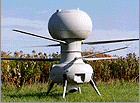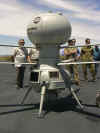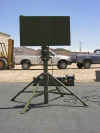FAS |
Military |
DOD 101 |
Systems |
Aircraft |
ROW ||||
Index |
Search |
Join FAS




CL-227 Sentinel
CL-327 Guardian
Canadair�s involvement with the US Navy started in 1988. Several demonstrations of the CL-227 were conducted to show the feasibility of launching and recovering a VTOL air vehicle from the deck of a small combatant ship. In a planned build up, land-based flight tests were conducted at the contractor�s site in Montreal Canada on a tether due to air space restrictions. Flights at Ft. Huachuca, AZ demonstrated the capability of a 20 km data link range. Flights were completed at Medicine Hat, Canada from a wooden deck to simulate the transition across the flight deck of a ship. A flight was accomplished aboard the Jan Tide (an oil rig replenishment ship) to a distance of 6 km from the ship. Although this was a manual flight and recovery, it continued the build up. The next at sea demo was conducted aboard the USS DOYLE (FFG-39) during a STANAVFORLANT cruise. Extensive flight testing both at the Canadair facility in Montreal and also at Patuxent River, MD preceded the cruise to demonstrate the safety of the system. Contractor personnel operated the system from a shelter inside the starboard hangar of the FFG. The final at sea demo was conducted aboard the USS VANDERGRIFT (FFG-48) and included automatic approaches to the deck using a UCARS system supplied by the Sierra Nevada Corp.
 The CL-327 is an improved version of the CL-227 Sentinel VTOL UAV. The CL-327 is one of the most advanced vertical takeoff and landing (VTOL) surveillance system designed for intelligence gathering today. The system's turboshaft-powered unmanned aerial vehicle (UAV) operates either from land or ship and can carry a wide variety of sensors for different mission requirements. The CL-327 is designed to satisfy numerous emerging market requirements for a dependable and versatile vertical take-off and landing (VTOL) UAV.
The Guardian offers 6.25 hours of endurance, a 105kg payload capacity, and a 200 km range. The system includes a Williams International heavy fuel engine, a digital data-link, compatibility with the CARS automatic recovery system, and the US sponsored Tactical Control Station.
The CL-327 entered production in October 1996, following the conclusion of a successful US Navy-sponsored heavy fuel propulsion program. The Guardian will be offered to worldwide customers seeking an affordable unmanned surveillance capability that can operate from all-sized navy ships and in rugged land environments which lack airstrips and infrastructure.
The CL-327 profits from unique maritime operational experiences garnered over ten years of VTOL UAV development which included numerous operational deployments aboard US Navy and NATO ships. Bombardier's at-sea experience has provided expertise in integrating VTOL UAVs aboard naval vessels, understanding the unique challenges of operating UAVs at sea, and improving and refining concepts of operations for UAVs at sea. The result is a marinized and shipboard compatible UAV system which has the endurance and payload to satisfy a myriad of maritime roles and missions.
Bombardier is also offering the Guardian VTOL system in a land configuration as a rapid and mobile surveillance asset. The system stores two air vehicles per HMMWV and trailer, a downsized UAV control station, and enough fuel and payloads for a 72 hour operation. Similar to the maritime configuration, the land version requires only two personnel to operate. No pilot skills are required and the crew can be trained in just four weeks.
The CL-327 is an improved version of the CL-227 Sentinel VTOL UAV. The CL-327 is one of the most advanced vertical takeoff and landing (VTOL) surveillance system designed for intelligence gathering today. The system's turboshaft-powered unmanned aerial vehicle (UAV) operates either from land or ship and can carry a wide variety of sensors for different mission requirements. The CL-327 is designed to satisfy numerous emerging market requirements for a dependable and versatile vertical take-off and landing (VTOL) UAV.
The Guardian offers 6.25 hours of endurance, a 105kg payload capacity, and a 200 km range. The system includes a Williams International heavy fuel engine, a digital data-link, compatibility with the CARS automatic recovery system, and the US sponsored Tactical Control Station.
The CL-327 entered production in October 1996, following the conclusion of a successful US Navy-sponsored heavy fuel propulsion program. The Guardian will be offered to worldwide customers seeking an affordable unmanned surveillance capability that can operate from all-sized navy ships and in rugged land environments which lack airstrips and infrastructure.
The CL-327 profits from unique maritime operational experiences garnered over ten years of VTOL UAV development which included numerous operational deployments aboard US Navy and NATO ships. Bombardier's at-sea experience has provided expertise in integrating VTOL UAVs aboard naval vessels, understanding the unique challenges of operating UAVs at sea, and improving and refining concepts of operations for UAVs at sea. The result is a marinized and shipboard compatible UAV system which has the endurance and payload to satisfy a myriad of maritime roles and missions.
Bombardier is also offering the Guardian VTOL system in a land configuration as a rapid and mobile surveillance asset. The system stores two air vehicles per HMMWV and trailer, a downsized UAV control station, and enough fuel and payloads for a 72 hour operation. Similar to the maritime configuration, the land version requires only two personnel to operate. No pilot skills are required and the crew can be trained in just four weeks.
CL-327 Specifications | |
| Country of Origin | Canada |
| Builder | |
| Missions |
|
| Engine | 1 Williams International WTS-125 turboshaft 125 shp flat rated at 100 shp |
| Height | 6 ft 0 in 1.84 m |
| Rotor diameter | 13 ft 1 in 4.00 m |
| Gross takeoff mass | 770 lbs. 350 kg |
| Empty weight | (no payload, no fuel) 330 lbs. 150 kg |
| Payload carrying capacity | 220 lbs. 100 kg |
| Maximum endurance | 6.25 hours |
| Time on station at 100 km | 4.75 hours |
| Maximum speed | 157 km/h / 85 kts |
| Climb rate | 7.6 m/sec / 1,500 ft/min |
| Ceiling | 5,500 m / 18,000 ft |
| Sensor |
|
| Datalink |
|
| Guidance and navigation |
|
| Image Exploitation |
|
| Crew | |
| Cost | |
| User Countries | |
| Air Views Ground View Bottom Shots Preparation for Launch Inside Views Communication |
Sources and Resources
- CL-327 Guardian Mishap Program Executive Office (Cruise Missiles and Joint Unmanned Aerial Vehicles) 10 June 1998
- CL-327 ACCIDENT MISHAP RESULTS RELEASED Program Executive Office (Cruise Missiles and Joint Unmanned Aerial Vehicles) 17 July 98
- UAV demo brings strange shapes over Eglin 53rd Wing Public Affairs 23 Dec 1999 -- Using Bombardier Aerospace's CL-327 Guardian UAV, special ops forces are able to receive real-time video to see what is ahead of them.
- Unmanned Surveillance Systems


FAS |
Military |
DOD 101 |
Systems |
Aircraft |
ROW ||||
Index |
Search |
Join FAS
http://www.fas.org/man/dod-101/sys/ac/row/cl-327.htm
Maintained by Robert Sherman
Originally created by John Pike
Updated Saturday, January 08, 2000 11:04:53 AM





















